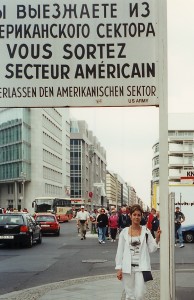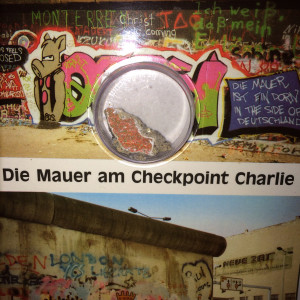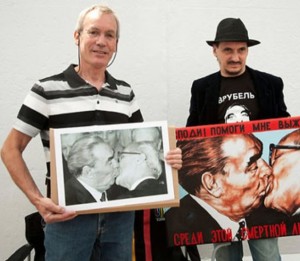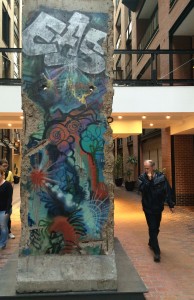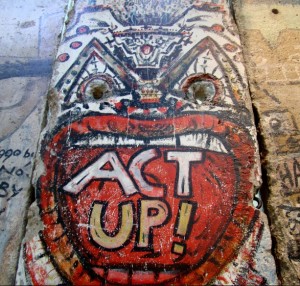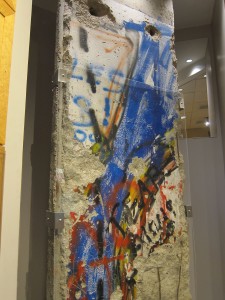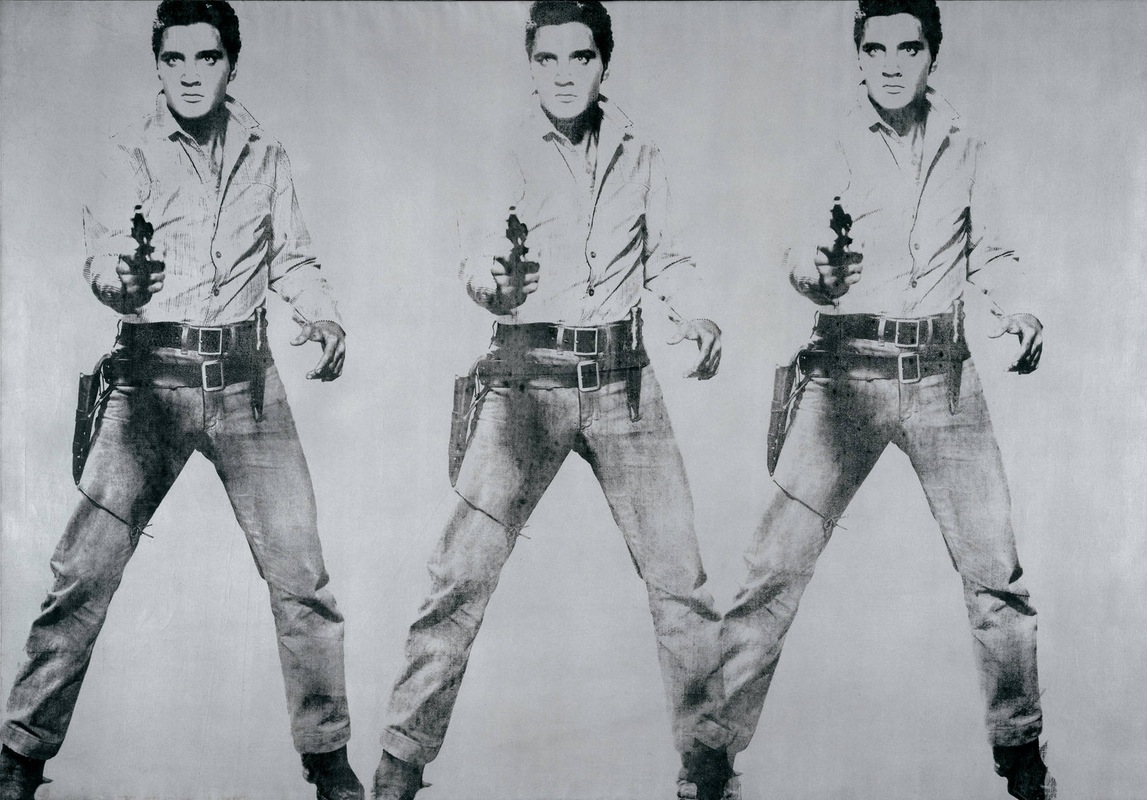Here’s one of my favorite works of art: Andy Warhol’s Elvis. It’s based on a publicity shot for Presley’s 1960 movie “Flaming Star.” This piece is one of a series of screenprinted Elvis paintings Andy created in 1963. The biggest is at The Andy Warhol Museum in Pittsburgh. It’s 36 feet long, 6.5 feet high and features 11 Elvises. Magnificent!
Music writer Peter Guralnick penned two excellent books about Elvis: “Last Train to Memphis – The Rise of Elvis Presley,” and “Careless Love – The Unmaking of Elvis Presley.” I Highly recommend them. There was a lot more to The King than you might imagine. In addition to being an enormous talent, he was intelligent, kind, and compassionate. Sure, he didn’t invent R&B wailing and fancy legwork – he copied much of that from the Southern black artists he loved – but he had the smarts to repackage it and the moxie to present it to a white audience trapped in an era of conformity and conservatism. RIP, Elvis!
Wow, I’m going to art school. Just like John and Keith and Freddie and Bowie! Getting accepted was easy enough. As a casual student with no dreams of actually obtaining a degree, all I needed was a Visa card number. No portfolio, no reference letters, no transcripts. I was free to learn and have fun!
Of course, the best part of starting a new school term is planning what to wear. I attempted to look the part of a tragically hip art student by wearing my black-and-white camo pants and an Avirex t-shirt topped with a fisherman’s vest purchased in a Tokyo thrift shop. For accessories, I chose my typewriter-key earrings, a bracelet made from rolled-up comic strips, and my Harajuku Swatch (with the phrase Orientalmagicity Tokyo, it’sabrassring, apieceofcake, howfan-fu**ing-tastic! printed on the inside of the band). Sort of a radical Fab2K update of my ’70s college look (which consisted of a variety of glam-rock influenced platform shoes that I wore through rain, snow, and sleet).
I even applied extra coats of Banana Boat self-tanning lotion the night before so that I would have that spring break college-chick look. But I was no match for the real Art Student. First, I don’t have a single piercing on any part of my body other than my ear lobes. Second, I’ve never looked good in any of the RGB, CMYK, or Pantone hair colors favored by the true Bohemians. And third, it was just too hot a day to wrap myself from head to toe in Gothic black. But that’s okay. Being different is good, especially in art school.
The students I encountered were very friendly and made a new gal feel right at home. Classmates were eager to help the old student re-boot her computer, unzip her files, and control-click her shortcuts.
 At lunchtime I shared a table with two teenaged girls, Kim and Kristen. Kim asked me if I was enjoying school. “Very much,” I replied between large mouthfuls of a sandwich the Art Institute calls a Po’ Boy (I guess it’s the local version of the famous Louisiana treat, Pittsburgh-ized with Isaly’s chip-chopped ham). In going with the flow, I said to Kim, “What’s your major?” “Interior design,” she replied.
At lunchtime I shared a table with two teenaged girls, Kim and Kristen. Kim asked me if I was enjoying school. “Very much,” I replied between large mouthfuls of a sandwich the Art Institute calls a Po’ Boy (I guess it’s the local version of the famous Louisiana treat, Pittsburgh-ized with Isaly’s chip-chopped ham). In going with the flow, I said to Kim, “What’s your major?” “Interior design,” she replied.
I half-jokingly asked if her course work included a class in Feng Shui. Kim blushed, saying she’d never heard of Feng Shui. Relishing this opportunity to mentor a younger student, I said, “Well, you know how sometimes when you walk into a room and you feel like throwing up? Well, that’s because your furniture’s horoscope signs are incompatible, your duct work is in retrograde, and your windows are in the yin position instead of the yang position. Result: bad Feng Shui.” Kim assured me she’d look into it.
Oh, you’re probably wondering about my course work. For the next 12 weeks I’ll be learning how to draw and design on the computer and also how to import images and manipulate them. Adobe Illustrator and Adobe Photoshop. More software. More expensive Mac hardware. A new scanner and something called a Firewire. Zip disks, too. More stuff. More money. All for the sake of shameless self-promotion projects.
© Dana Spiardi, July 3, 2000
Die Nasty. Dream Orphans. Beat My Guest. Highway to Heck. No, these aren’t names of punk rock groups or titles of angst-ridden, teen-penned poems. They’re names of fonts. Four evocatively named fonts that co-exist among the hundreds of others in my Mac. Fonts that compete on a daily basis to be chosen for use in one of my literary or graphic masterpieces (ahem).
I’ve rarely met a font I didn’t fall in love with. I’ve cruised the Internet super highways by night, luring new fonts to my harem. I’ve risked system contamination, blindly downloading free fonts from fly-by-night sites with seedy names like FontLust.com. Rogue fonts now reside alongside legitimate fonts that automatically enter the neighborhood every time I install new publishing software. Ah, but this indiscriminate font love now poses a major digital dilemma: I simply have more fonts than I can fathom.
Before Apple introduced OS X, with its easy-to-use Font Book management tool, maintaining large font collections was somewhat tricky. I was warned that my obsessive accumulation of font families would suffocate my operating system. This led me to purchase Font Reserve, an application that was highly rated as one of the best font management tools on the market. Font Reserve allowed me to activate only those font groups that I was currently interested in using, thus reducing the risk of font overload on the system.
When I upgraded to iLife ’04 in 2003, I was thrilled to see that its Font Book application could perform the same functions as Font Reserve. Plus, with Font Book, all of my fonts could be active at the same time!
I established categories within Font Book, organizing my darlings into groups such as modern, classic, outline, space age, scary, ethnic, bold, novelty, curly and old-fashioned. This has taken a lot of time, and I still haven’t categorized most of the newest font additions. And, although the WYSIWYG feature works when I’m using MS Word, it doesn’t apply in Photoshop or any of the other Adobe programs!
Perhaps it’s time to purchase a more powerful font management application. An April 2005 article in MacWorld.com states: “Thanks to OS X 10.3’s Font Book, most Mac users don’t need to buy a font management program. But if you have tons of fonts, share a font library with others, or have lots of fonts flowing through your system (from clients or collaborators, for example) you’ll need more features than Font Book offers.” The article reviews: Font Agent Pro 3.0 – four mice; Font Doctor 7.0 – four mice; and Master Juggler 3.0.3 – two mice.
A March 2007 MacWorld.com article reviews Suitcase Fusion, a font manager that “combines the best of Suitcase X1 and Font Reserve 3.” MacWorld gives this application a four-and-half mice rating.
Once again I’m faced with a major decision: buy new software or learn to live with what I have? The intelligent choice is to apply the tenets of a 12-step program to my font addiction, exercise some self-control, and start deleting fonts from the system. Only time will tell if Relish Gargler, A Yummy Apology, and Tibetan Beefgarden survive the cut!
]]>